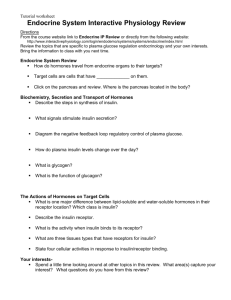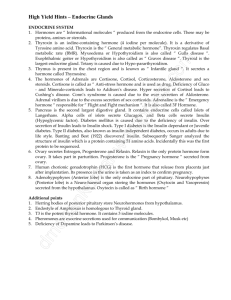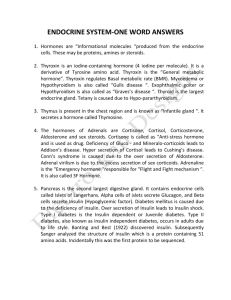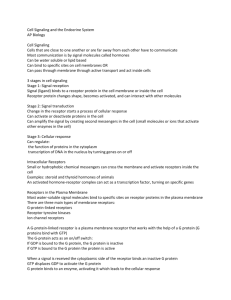bch answers - Covenant University
advertisement
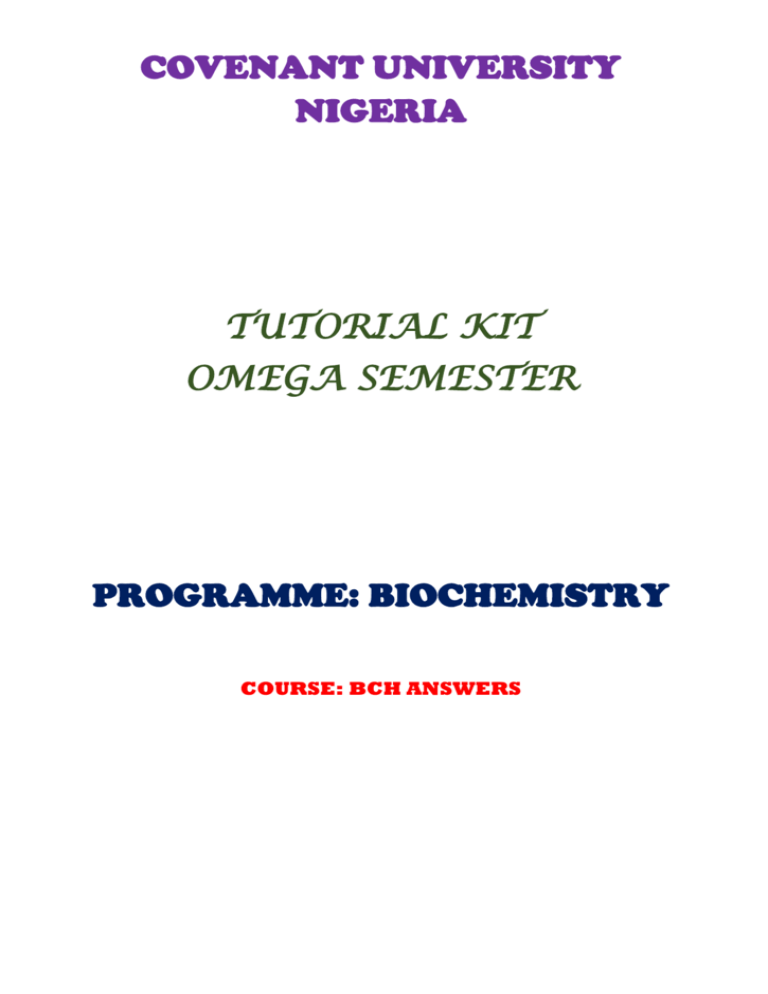
COVENANT UNIVERSITY NIGERIA TUTORIAL KIT OMEGA SEMESTER PROGRAMME: BIOCHEMISTRY COURSE: BCH ANSWERS DISCLAIMER The contents of this document are intended for practice and leaning purposes at the undergraduate level. The materials are from different sources including the internet and the contributors do not in any way claim authorship or ownership of them. The materials are also not to be used for any commercial purpose. ANSWERS 1. Present an overview of the endocrine system with detailed description of the location, anatomy and function of the major glands. Definition of the endocrine system The endocrine system is a system of glands, each of which secretes a type of hormone to regulate body functions. It is an information signal system much like the nervous system. The endocrine system consists of a group of ductless glands and organs that regulate and control various body functions by producing and secreting hormones. Ten (10) major glands 1. Hypothalamus – a small region of the brain 2. The pituitary gland- floor of the brain 3. Pineal gland – brain 4. The thyroid gland - neck 5. The parathyroid gland - neck 6. Thymus gland - straddled across the trachea and bronchi in the upper thorax 7. The islets of the pancreas – within the pancreas behind the stomach 8. The adrenal glands – on the kidney 9. The testes in men and the ovaries in women (gonads) – pelvic cavity. 10. The placenta (during pregnancy) also acts as an endocrine gland in addition to its other functions. Access the hormones secreted by the glands and their biochemical effects/functions from Lecture notes, textbooks and other resource materials. Figure 1: Major endocrine glands and their location Source: Lehninger Principles of Biochemistry, 4th Edn., 2005. 3. Discuss exhaustively the six (6) molecular mechanisms of signal transduction in living systems. The six (6) molecular mechanisms of signal transduction in living systems i. Gated ion channels of the plasma membrane ii. Receptor enzymes iii. Receptor proteins (serpentine receptors) iv. Nuclear receptors (steroid receptors) v. Receptors that lack enzymatic activity vi. Receptors (adhesion receptors) a. Diagrammatic illustration Figure 2 Six general types of signal transducers Source: Lehninger Principles of Biochemistry, 4th Edn., 2005. b. Detailed description of each mechanism i. Gated ion channels of the PM These allow the regulated passage of inorganic ions like Na+, K+, Ca2+ and Cl across the plasma membrane based on stimuli response. Nicotinic acetylcholine (AC) receptor is one of the best-understood examples of a ligand-gated receptor channel and the other type is the voltage-gated ion channel. There are three types: voltage-gated Na +, K + & Ca2+ ion channels. ii. Receptor enzymes Receptor enzymes (RE) possess a ligand-binding domain on the extracellular surface of the plasma membrane and an enzyme active site on the cytosolic side: the two domains are connected by a single transmembrane segment. RE is a protein kinase (PK) that phosphorylates Tyrosine residues in specific target proteins. A standard example of receptor enzymes is the insulin receptor. In plants, the PK is specific for Serine or Threnine residues. Other receptor enzymes synthesize the intracellular second messenger cGMP in response to extracellular signals. iii. Receptor proteins (serpentine receptors) The third mechanism which is outrightly different from gated ion channels and receptor enzymes. Receptor proteins are identified by three (3) essential components: 1. A plasma membrane receptor with seven transmembrane helical segments 2. An enzyme in the plasma membrane that generates an intracellular second messenger and 3. A guanosine nucleotide–binding protein (G protein). The moment the ligand specific for a receptor protein binds, the receptor becomes activated and this in turn stimulates the G protein (a trimer with α, β, and γ subunits) by exchanging bound GDP for GTP. The GTP-bound γ subunit protein then dissociates from the occupied receptor and binds to a nearby enzyme, adenylyl cyclase; altering its activity. This enzyme then catalyzes the production of a second messenger e.g. cyclic AMP which activates downstream enzymes. The β-adrenergic receptor is the prototype for this molecular mechanism of signal transduction and it mediates the effects of epinephrine on many tissues such as muscle, liver and adipose tissues. These receptors regulates fuel metabolism. iv. Nuclear receptors (steroid receptors) Nuclear receptors alter the rate at which specific genes are transcribed and translated into cellular proteins; they carry out this task by being bound to their specific ligand (e.g. hormone estrogen), undergo a conformational change that affects a segment of the DNA molecule (hormone response elements: HREs) close to the gene to be expressed thereby triggering the gene to be released. They function through mechanisms intimately related to the regulation of gene expression. v. Receptors that lack enzymatic activity These attract and activate cytoplasmic enzymes that act on downstream proteins in either of two ways: by directly converting them to gene-regulating proteins or by activating a cascade of enzymes that finally activates a gene regulator. The JAK-STAT system exemplifies the first mechanism and the TLR4 (Toll) signaling system in humans, the second. Receptors (adhesion receptors) These interact with macromolecular components of the extracellular matrix (such as collagen) and convey to the cytoskeletal system instructions on cell migration/ adherence to the matrix. Integrins which represent this class of receptors are heterodimeric proteins (two unlike subunits: α and β anchored to the plasma membrane by a single hydrophobic transmembrane helix in each subunit. The large extracellular domains of the α and β subunits combine to form a specific binding site for extracellular proteins such as collagen and fibronectin. 5. Epinephrine and norepinephrine double as neurotransmitters and hormones in respective target tissues thereby transmitting their signals through a unique class of cell surface receptors. Identify and fully describe the significance of these receptors. Three (3) names of receptors mentioned 1. G-protein coupled receptors (GPCRs) 2. Serpentine receptors 3. Seven transmembrane (7tm) helical segment Description of the receptor 1. A plasma membrane receptor with seven transmembrane helical segments 2. An enzyme in the plasma membrane that generates an intracellular second messenger and 3. A guanosine nucleotide–binding protein (G protein). When GPCR binds its ligand, it becomes activated and in turn stimulates the associated G protein (a trimer with α, β, and γ subunits) by exchanging bound GDP for GTP. The GTP-bound γ subunit protein then dissociates from the occupied receptor and binds to a nearby enzyme, adenylyl cyclase; altering its activity. This enzyme then catalyzes the production of a second messenger e.g. cyclic AMP which activates downstream enzymes. The β-adrenergic receptor is the prototype for this molecular mechanism of signal transduction and it mediates the effects of epinephrine on many tissues such as muscle, liver and adipose tissues. Explore lecture materials and textbooks for details on action mechanism and specific cellular response/metabolic processes regulated. 7. (a) Trace the biosynthetic pathway of the six (6) classes of hormones based on structure. (b) Give at least an example of each of these six (6) classes of hormones and their respective biochemical effects in living systems. Table 1: Summary of the Biosynthetic pathway for each of the classes based on structures Source: Lehninger Principles of Biochemistry, 4th Edn., 2005. Get details from textbooks. 9. What do you understand by tropic and nontropic hormones? Give two examples of each. b. Outline all the pituitary gland hormones and discuss their specific role in metabolic activities and other physiological functions. c. Why is pituitary called the master gland? Definition of tropic and nontropic hormones Tropic hormones are hormones that regulate secretion by another endocrine gland and nontropic hormones are those that do not regulate secretion by another endocrine gland. Examples of tropic hormones are those of the pituitary and hypothalamus such as 1. Gonadotropins: Luteinizing hormone and Follicle-stimulating hormone 2. Thyrotropin 3. Adrenocorticotropin (ACTH) 4. Adrenocorticotropin-releasing factor 5. Thyrotropin Releasing factor Pituitary glands hormones listed 1. Prolactin (PRL) 2. Growth Hormone (GH) 3. Thyroid-stimulating Hormone (TSH) 4. Adrenocorticotropic Hormone (ACTH) 5. Follicle-stimulating hormone (FSH) 6. Luteinizing hormone (LH) 7. Endorphins (Endogenous morphines) e.g. Enkephalins 8. Melanocyte-stimulating hormones (MSH) 9. Oxytocin 10. Vasopressin (Antidiuretic hormone, ADH) Metabolic roles available in lecture materials and textbooks. Pituitary is called the master gland because it controls the function of most other endocrine glands 11. Give a detailed explanation of diseases associated with hormone dysfunction. i. Three (3) main categories of diseases 1. Endocrine gland hyposecretion 2. Endocrine gland hypersecretion 3. Tumours of endocrine gland Seven (7) named examples from any of the categories 1. Pituitary dwarfism 2. Hyperthyroidism 3. Diabetes mellitus 4. Diabetes insipidus 5. Hypothyroidism 6. Addison’s disease (Hypoadrenocortism) 7. Cushing’s disease (Hyperadrenocortism) 8. Multiple endocrine neoplasia (MEN type 1, 2a & 2b) 9. Carcinoid syndrome Explore texts and lecture materials for other details: metabolic pathway(s) affected and resultant symptom of disease or disorder; possible treatment or relevant biochemical equation or illustration. 13. A variety of stressors stimulate release of corticosteroid hormone, cortisol from the adrenal cortex; outline seven (7) of these stressors. Discuss the functions and mechanism of action of this steroid hormone on its three (3) target tissues. Seven stressors 1. Anxiety 2. Fear 3. Pain 4. Infection 5. Low blood sugar 6. Haemorrhage 7. Starvation Structure of cortisol Figure 3 Structure of cortisol Three (3) target tissues: muscle, liver and adipose tissues Summary of metabolic function: Affects protein and carbohydrate metabolism; suppresses immune response, inflammation, and allergic responses. Explore texts and lecture materials for metabolic functions of cortisol and mechanism of action. i. Diagrammatic illustration Figure 4 Cascade of hormone release following CNS input to the hypothalamus 15.Write in detail on a named peptide hormone, highlighting its synthesis, mechanism of action and metabolic process or processes it regulates. b. i. A named peptide hormone: Insulin, glucagon, somatostatin, oxytocin, vasopressin e.t.c ii. Details of biosynthesis Insulin is produced in the beta cells of the pancreatic islets. It is initially synthesized as a single-chain 86amino-acid precursor polypeptide, preproinsulin. Subsequent proteolytic processing removes the aminoterminal signal peptide, giving rise to proinsulin. Proinsulin is structurally related to insulin-like growth factors I and II, which bind weakly to the insulin receptor. Cleavage of an internal 31-residue fragment from proinsulin generates the C peptide and the A (21 amino acids) and B (30 amino acids) chains of insulin, which are connected by disulfide bonds. The mature insulin molecule and C peptide are stored together and cosecreted from secretory granules in the beta cells iii. Mechanism of action explained a. Second-messenger systems- Insulin is a water-soluble hormones (Lipophobic hormones) b. Hormone binds to its receptor (e.g. insulin receptor) on the plasma membrane c. Receptor (tyrosine kinase activity in the case of insulin) is activated and recruits other enzyme/downstream proteins d. Muscle, fat and liver tissues require insulin to transport glucose into the cells; in these tissues insulin seems to increase the number of glucose transporters in the cell membrane e. Insulin also increases activity of enzymes that cause storage of sugar as glycogen or lipid f. After a meal blood sugar rises and this stimulates the release of insulin from the pancreas; g. Extra insulin then causes the sugar to enter the cells and become stored OR iii. Mechanism of action explained Once insulin is secreted into the portal venous system, ~50% is degraded by the liver. Unextracted insulin enters the systemic circulation where it binds to receptors in target sites. Insulin binding to its receptor stimulates intrinsic tyrosine kinase activity, leading to receptor autophosphorylation and the recruitment of intracellular signaling molecules, such as insulin receptor substrates (IRS) (Fig. 2). IRS and other adaptor proteins initiate a complex cascade of phosphorylation and dephosphorylation reactions, resulting in the widespread metabolic and mitogenic effects of insulin. As an example, activation of the phosphatidylinositol-3'-kinase (PI-3-kinase) pathway stimulates translocation of glucose transporters (e.g., GLUT4) to the cell surface, an event that is crucial for glucose uptake by skeletal muscle and fat (1 mark). Activation of other insulin receptor signaling pathways induces glycogen synthesis, protein synthesis, lipogenesis, and regulation of various genes in insulin-responsive cells. iv. Metabolic processes it regulates discussed in detail a. The hormone insulin is the primary regulatory signal in animals, suggesting that the basic mechanism is very old and very central to animal life. Insulin regulates glucose, or sugar uptake, by helping it move from the blood into cells. When present, it causes many tissue cells to take up glucose from the circulation, causes some cells to store glucose internally in the form of glycogen, causes some cells to take in and hold lipids, and in many cases controls cellular electrolyte balances and amino acid uptake as well. Its absence turns off glucose uptake into cells, reverses electrolyte adjustments, begins glycogen breakdown and glucose release into the circulation by some cells, begins lipid release from lipid storage cells, etc. Circulatory glucose levels are the most important signal to the insulin producing cells, and as they are largely due to dietary carbohydrate intake, diet controls major aspects of metabolism via insulin. Regardless of insulin levels, no glucose is released to the blood from internal glycogen stores from muscle cells. Diagrammatic illustration Figure 5: Conversion of proinsulin to insulin by β peptidases Figure 6: Second-messenger systems OR Figure 7: Mechanism of Insulin action Figure 8: Mechanism of G-protein coupled hormone receptors Source: Lehninger Principles of Biochemistry, 4th Edn., 2005. SECTION 3 PREPARED BY MR. O.S. ADEGBITE 1. What are aquaporins Water crosses cell membranes by diffusion through the lipid bilayer, through water channel proteins called Aquaporins. In 1992 a "water channel" was identified and what its molecular machinery might look like was suggested; that is, proteins were identified that formed an actual channel in membranes that facilitated water movement. In the mid-1980s Peter Agre, studied various membrane proteins isolated from the red blood cells. He also found one of these in the kidney cells. Having determined both its peptide sequence and the corresponding DNA sequence, he speculated that this might be the protein of the so-called cellular water channel. He termed this channel protein – aquaporin. Aquaporin proteins are made up of six transmembrane α-helices arranged in a right-handed bundle, with the amino and the carboxyl termini located on the cytoplasmic surface of the membrane. The amino and carboxyl halves of the sequence show similarity to each other, in what appears to be a tandem repeat. Some researchers believe that this results from an early evolution event which saw the duplication of the half-sized gene. There are also five interhelical loop regions (A – E) that form the extracellular and cytoplasmic vestibules. Loops B and E are hydrophobic loops which contain the highly, although not completely conserved Asn-Pro-Ala (NPA) motif, which overlap the middle of the lipid bilayer of the membrane forming a 3-D 'hourglass' structure where the water flows through. This overlap forms one of the two well-known channel constriction sites in the peptide, the NPA motif and a second and usually narrower constriction known as 'selectivity filter' or ar/R selectivity filter (4mks). There have been two clear examples of diseases identified as resulting from mutations in aquaporins: Mutations in the aquaporin-2 gene cause hereditary nephrogenic diabetes insipidus in human. Mice homozygous for inactivating mutations in the aquaporin-0 gene develop congenital cataracts. (1mk) (3mks) Structure of aquaporin 2. Discuss a disease associated with membrane function TYPE 2 DIABETES MELLITUS (2mks) Diabetes mellitus is a group of metabolic diseases characterized by elevated blood glucose levels (hyperglycemia) resulting from defects in insulin secretion, insulin action or both. Type 2 diabetes is the result of failure to produce sufficient insulin and insulin resistance in the liver and skeletal muscle, increased glucose production in the liver, over production of free fatty acids by fat cells and relative insulin deficiency. Insulin secretion decreases with gradual beta cell failure. (2mks) In biological membranes, the insulin receptors are responsible for transducing signals by insulin from hyperglycemia. Affected downstream metabolic pathways are glycogenesis, synthesis of fatty acids and cholesterol. In abnormal cases where insulin receptors develop diminished sensitivity to insulin and certain insulin-like growth factors, type 2 diabetes mellitus emerges. (5mks) Because cells need ATP for survival and suicide (apoptosis), they result to breakdown of fat stores which when excessive generate ketone bodies. This is a prerequisite for ketoacidosis observed in diabetic patients. (2mks) Contributing factors: – Obesity – Age (onset of puberty is associated with increased insulin resistance) – Lack of physical activity – Genetic predisposition – Racial/ethnic background (African American, Native American, Hispanic and Asian/Pacific Islander) – Conditions associated with insulin resistance, (e.g., polycystic ovary syndrome) (2mks) Elevated blood glucose levels are managed with reduced food intake, increased physical activity, and eventually oral medications or insulin. (2mks) 3. What do you understand by membrane fluidity State Fick’s law FICK’S LAW: The rate of diffusion (mol/sec) across a membrane is directly proportional to the difference in concentration (c2-c1) across both sides of the membrane, to the area (A) of the membrane and to the permeability coefficient (P) which itself is inversely proportional to the thickness (d) of the membrane. (5mks) 4. Define endocytosis 5. What are second messengers 6. Discuss a disease associated with hormonal function
